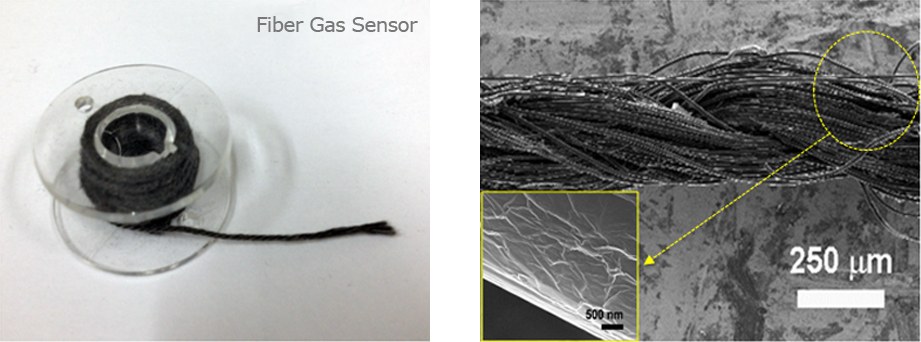

Smart Clothes that Smell and Detect Gas
A group of researchers at ETRI have developed a washable, flexible, and ultrasensitive fiber gas sensor.
With this technology, existing fiber, such as nylon, cotton, or polyester,
is coated with graphene by means of a molecular adhesive so that it can detect any gas existing in the air.
This gas sensor is able to selectively detect nitrogen dioxide at room temperature with commercial fiber
by choosing reduced graphene oxide as a detector material to maintain the flexible quality of the fiber.
Since the fiber is firmly coated with reduced graphene oxide in the shape of a molecular film,
assisted by the molecular adhesive, it can still serve as a reliable, flexible gas sensor even when it is bent or washed.

Invariable Performance When Bent a Thousand Times
With the successful development of a gas sensor with flexibility to the degree of coiling
around a lead in a mechanical pencil, it is expected to become much easier
to detect any harmful gas in the air by attaching the sensor to a wearable device or clothes.
In particular, firefighters who approach the scene of a fire or
enter a manhole will be able to identify the air conditions with a pre-connected device.
One of the most notable qualities is that this gas sensor maintains its desired
performance even when washed or bent more than 1,000 times.
In addition, as this sensor exists in the form of thread or fiber with a thickness of a few micrometers or millimeters,
it can work with a detector material without causing additional power consumption.
When this technology is applied to logos attached onto clothes,
it becomes possible to make clothes blink based on changed resistance
by using the near field communication(NFC) for connection with a smartphone or utilizing a LED to detect harmful gas.

Clothes that Inform Air Quality
Using commercial fiber, this technology can be immediately adopted in related industries,
because it involves a simple process to coat and reduce the molecular adhesive and detector material,
and therefore the process of developing a gas sensor is suitable for mass-production.
As a result, outdoor wearers will be able to receive relevant information about the quality of external air.
In addition, air-purifying filters made with fiber(non-woven fabric) will help improve air quality.
Fiber gas sensors will therefore serve as a smart filter that can both filter air and detect harmful gas.
Dr. Hyung-Kun Lee, who is in charge of this research initiative, stated,
“This sensor can bring a significant change to our daily life since it was developed with flexible and widely used fiber,
unlike the gas sensors invariably developed with the existing solid substrates.”
The outcomes of this research were published on June 4 in the online edition of Scientific Reports, a journal from the publishers of Nature.













